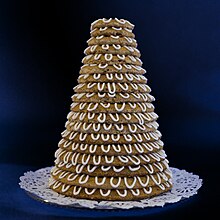Loading AI tools
Traditional Danish and Norwegian confection From Wikipedia, the free encyclopedia
kransekage (Danish: [ˈkʁ̥ɑnsəˌkʰæːjə]) or Kransekake (Norwegian) is a traditional Danish and Norwegian confection , often eaten on special occasions in Scandinavia. In English, the name means 'wreath cake'. In Norway it is alternatively referred to as tårnkake (English: 'tower cake') and often prepared for Constitution Day celebrations, Christmas, weddings, and baptisms. In Denmark it is typically eaten as part of New Year celebrations, while a variation of the cake, overflødighedshorn, is traditionally served at weddings and baptisms.[1][2]
This article should specify the language of its non-English content, using {{lang}}, {{transliteration}} for transliterated languages, and {{IPA}} for phonetic transcriptions, with an appropriate ISO 639 code. Wikipedia's multilingual support templates may also be used. (January 2023) |
 An 18-layer kransekake decorated with white icing | |
| Alternative names | kransekage, kransekake, kransakaka |
|---|---|
| Type | Cake |
| Course | Dessert |
| Place of origin | Denmark |
| Region or state | Scandinavia |
| Serving temperature | Cold |
| Main ingredients | Almonds, sugar, egg whites |
| Variations | Overflødighedshorn |
The origin of the kransekage can be traced to the 18th century, where it was first created by a baker in Copenhagen.[citation needed]
A kransekage takes the form of a series of concentric rings of cake, layered on top of each other in order to form a steep-sloped cone shape—often 18 or more layers—stuck together with white icing. Kransekake cake rings are made with almonds, sugar, and egg whites.[3][1] The ideal kransekake is hard to the touch, yet soft and chewy.
This confection is served by separating individual rings and breaking them into smaller pieces. In recent years the kransekake when mass-produced is sold year round in the shape of dessert bars. Mass-produced kransekake is available in stores around Christmas and before New Year's Eve.
One cultural tradition is for the wedding couple to lift the top layer of the cake at their wedding. The number of cake rings that stick to the top one when they lift it is said to be the number of children the couple will have.[3]
The world's tallest kransekake was baked in 2006 by the supermarket Coop in Oslo in celebration of their 100th anniversary. The cake was 13.17 meters tall and made from over 700 kilograms of dough.[4][5]
The original variant used at weddings is called overflødighedshorn (English: 'horn of plenty') and is shaped like a cornucopia and filled with chocolates, cookies, and other small treats. Sometimes a bottle of wine or akvavit is placed in the center, and the cake is decorated with ornaments such as crackers and flags.
Bite-sized versions of the cake, called kransekakestenger (English: 'wreath cake rods') are often prepared for Christmas. The cake is prepared in the same way as with the original version, but instead of being formed into rings they are set into small, straight portions between 5–8 cm (2–3 in) long. They are then similarly decorated with white icing, though they may also be dipped in chocolate.[6]
Seamless Wikipedia browsing. On steroids.
Every time you click a link to Wikipedia, Wiktionary or Wikiquote in your browser's search results, it will show the modern Wikiwand interface.
Wikiwand extension is a five stars, simple, with minimum permission required to keep your browsing private, safe and transparent.